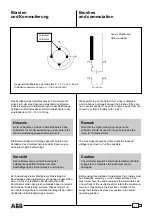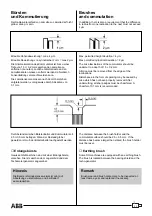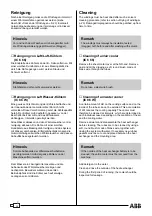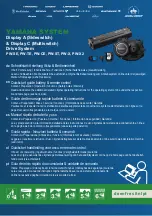
23
Inspection
and maintenance
■
Example:
In the winding of a 460V motor, the insulation resistance
has been measured to 100 M
Ω
at 30
°
C. We obtain from
the diagram:
K t40
°
C at 30
°
C = 0.1.
The recommended minimum insultation resistance Rm’
according to formula (1 ) is:
Rm = 0.460 + 1.0 = 1,46 M
Ω
According to formula (2):
R 40
°
C = 0.1 x 100 = 10 M
Ω
CONCLUSION :
R40
°
C is larger than Rm and the insulation resistance
is approved.
■
Drying of windings
The drying of windings should be done with care.
The temperature increase should not be more than about
5
°
C per hour and the final temperature should not
exceed about 100
°
C.
If the temperature is increased too quickly, or too high, a
winding temperature is reached, where the moisture
vaporizes inside the insulation which can result in
damage of the insulation.
Remark
The temperature should be carefully supervised
during the drying cycle.
The insulation resistance will drop to start with as a result
of the temperature increase, but will rise again when the
insulation gets dryer.
Remark
The drying process should not be interrupted until the
insulation resistance has remained the same on
several measuring occasions. Good ventilation must
be ensured to remove the moisture completely.
With oven drying, the only task is the supervision of
the temperature increase and the peak temperature.
The goods temperature should be about 90
°
C for
12-16 hours and then about 100
°
C for 6-8 hours.
The total required heating power can be calculated from
the following formula:
Pa =
M
kW
1000
Where: Pa = total power in kW
M = motor weight in kg
Überwachung
und Unterhalt
■
Beispiel :
An der Wicklung eines 460 V Motors ist ein
Isolationswiderstand von 100 M
Ω
bei 30
°
C gemessen
worden. Aus dem Diagramm ergibt sich :
K
t40
°
C
bei 30
°
C = 0,1
Der empfohlene Mindestwert des Isolationswiderstandes
Rm wird nach Formel (1) :
R
m
= 0,460 + 1,0 = 1,46 M
Ω
Nach Formel (2) :
R
40
°
C
= 0,1 x 100 = 10 M
Ω
SCHLUSSFOLGERUNG :
R
40
°
C
ist größer als R
m
und der Isolationswiderstand
wird als gut bezeichnet.
■
Trocknen der Wicklungen
Das Trocknen von Wicklungen soll mit einer gewissen
Vorsicht geschehen. Die Temperatursteigerung soll nicht
mehr als 5
°
C pro Stunde betragen.
Die Endtemperatur darf 100
°
C nicht übersteigen.
Zu schnelles Erwärmen und zu hohe Temperatur können
zum Verdunsten der Feuchtigkeit in den Poren des
Isolationsmaterials führen, das dabei zerstört wird.
Hinweis
Während des Trocknens ist die Temperatur genau zu
überwachen.
Aufgrund der Temperaturerhöhung sinkt der
Isolationswiderstand am Anfang und steigt später wenn
die Isolation trocken ist.
Hinweis
Der Trocknungsvorgang darf erst abgebrochen
werden wenn durch mehrere Messungen festgestellt
wurde, daß der Isolationswiderstand unverändert
bleibt. Beim Trocknen ist gute Durchlüftung
Voraussetzung um den Feuchtigkeitsentzug zu
gewährleisten. Beim Trocknen im Ofen müssen
lediglich Temperaturanstieg und Maximaltemperatur
überwacht werden. Die Temperatur der Wicklungen
soll für 12 - 16 Stunden bei ca. 90
°
C und
anschließend für 6 - 8 Studen bei ca. 100
°
C liegen.
Die Temperaturüberwachung sollte mit Thermoelementen
oder Kontaktthermometern erfolgen.
Die erforderliche Heizleistung läßt sich aus folgender
Formel errechnen :
Pa =
M
kW
1000
wobei : Pa = Heizleistung in kW
M = Motorgewicht in kg
















































